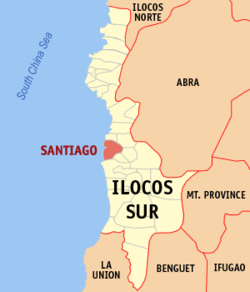Santiago, Ilocos Sur
| Santiago | ||
|---|---|---|
| Municipality | ||
|
A beach in Ambucao | ||
| ||
 Map of Ilocos Sur showing the location of Santiago | ||
.svg.png) Santiago Location within the Philippines | ||
| Coordinates: 17°18′N 120°27′E / 17.300°N 120.450°ECoordinates: 17°18′N 120°27′E / 17.300°N 120.450°E | ||
| Country | Philippines | |
| Region | Ilocos (Region I) | |
| Province | Ilocos Sur | |
| District | 2nd District | |
| Barangays | 24 | |
| Government[1] | ||
| • Mayor | Josefino E. Miranda | |
| Area[2] | ||
| • Total | 46.36 km2 (17.90 sq mi) | |
| Population (2010)[3] | ||
| • Total | 17,958 | |
| • Density | 390/km2 (1,000/sq mi) | |
| Time zone | PST (UTC+8) | |
| ZIP code | 2707 | |
| Dialing code | 77 | |
| Income class | 4th class | |
Santiago is a fourth class municipality in the province of Ilocos Sur, Philippines. According to the 2010 census, it had a population of 17,958 people.[3]
Santiago Cove is dubbed as the "Boracay of Ilocos Sur" because of its white sands.[4]
Santiago is the headquarters of the Ilocos Sur Electric Cooperative (ISECO), which distributes electricity to the entire province.
Barangays
Santiago is politically subdivided into 24 barangays.[2]
- Al-aludig
- Ambucao
- San Jose (Baraoas)
- Baybayabas
- Bigbiga
- Bulbulala
- Busel-busel
- Butol
- Caburao
- Dan-ar
- Gabao
- Guinabang
- Imus
- Lang-ayan
- Mambug
- Nalasin
- Olo-olo Norte
- Olo-olo Sur
- Poblacion Norte
- Poblacion Sur
- Sabangan
- Salincub
- San Roque
- Ubbog
History
Before the Spanish Conquest of the Philippines, Moro raiders were in control, so one of the tasks of the Spanish was to pacify and clear the country of these pirates. Coastal communities (Northern Luzon, and, thus, Ilocos) were prone to piratical attacks. For these, watchtowers were erected all over the Ilocos coast.
The Spanish started patrols of sea lanes, stopping these pirates for a while, only for them to resurface in 1772. But in the place now known as Santiago, as the Spanish engaged the pirates, all church bells ringing and trumpets sounded (to signal their attacks), the Augustinians stationed in the place held a statue of Santiago (Saint James) facing the sea and with many natives praying the rosary for safety and victory. The Moros fled, never to return, thus sparing the pueblo. The place was since then named Santiago.
It was once a visita of Narvacan due to the lack of ministers at the time.
Demographics
| Population census of Santiago | ||
|---|---|---|
| Year | Pop. | ±% p.a. |
| 1990 | 14,427 | — |
| 1995 | 14,843 | +0.53% |
| 2000 | 15,876 | +1.45% |
| 2007 | 16,806 | +0.79% |
| 2010 | 17,958 | +2.44% |
| Source: National Statistics Office[3][5] | ||
Image gallery
- A field of tobacco growing in Baybayabas
- A man fishing just offshore near to Sabangan Beach.
References
- ↑ "Official City/Municipal 2013 Election Results". Intramuros, Manila, Philippines: Commission on Elections (COMELEC). 1 July 2013. Retrieved 20 September 2013.
- 1 2 "Province: ILOCOS SUR". PSGC Interactive. Makati City, Philippines: National Statistical Coordination Board. Retrieved 20 September 2013.
- 1 2 3 "Total Population by Province, City, Municipality and Barangay: as of May 1, 2010" (PDF). 2010 Census of Population and Housing. National Statistics Office. Retrieved 20 September 2013.
- ↑ "Sunrise at Santiago". Retrieved 14 January 2008.
- ↑ "Province of Ilocos Sur". Municipality Population Data. LWUA Research Division. Retrieved 20 September 2013.
External links
- Pasyalang Ilocos Sur
- Philippine Standard Geographic Code
- Philippine Census Information
- Local Governance Performance Management System
 |
San Esteban | Burgos |  | |
| South China Sea | |
Lidlidda | ||
| ||||
| | ||||
| Candon | Banayoyo |
